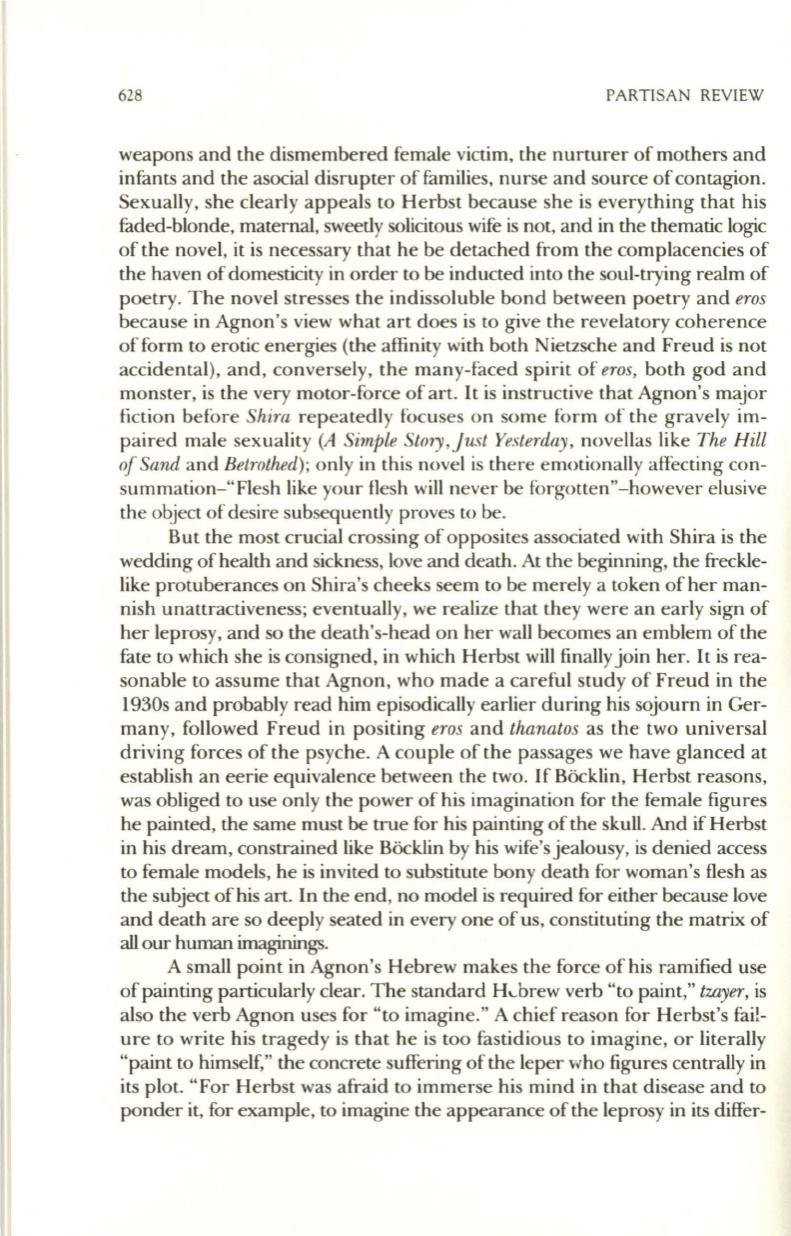
628
PARTISAN REVIEW
weapons and the dismembered female victim, the nurturer of mothers and
infants and the asocial disrupter of families, nurse and source of contagion.
Sexually, she clearly appeals to Herbst because she is everything that his
faded-blonde, maternal, sweetly solicitous wife is not, and in the thematic logic
of the novel, it is necessary that he be detached from the complacencies of
the haven of domesticity in order to be inducted into the soul-trying realm of
poetry. The novel stresses the indissoluble bond between poetry and
eros
because in Agnon's view what art does is to give the revelatory coherence
ofform to erotic energies (the affinity with both Nietzsche and Freud is not
accidental), and, conversely, the many-faced spirit of
eros,
both god and
monster, is the very motor-force of art. It is instructive that Agnon's major
fiction before
Shim
repeatedly focuses on some form of the gravely im–
paired male sexuality
(A Simple Story,Just Yesterday,
novellas like
The Hill
oj Sand
and
Betrothed);
only in this novel is there emotionally aflecting con–
summation-"Flesh like your flesh will never be forgotten"-however elusive
the object of desire subsequently proves to be.
But the most crucial crossing of opposites associated with Shira is the
wedding of health and sickness, love and death. At the beginning, the freckle–
like protuberances on Shira's cheeks seem to be merely a token of her man–
nish unattractiveness; eventually, we realize that they were an early sign of
her leprosy, and so the death's-head on her wall becomes an emblem of the
fate to which she is consigned, in which Herbst will finally join her. It is rea–
sonable to assume that Agnon, who made a careful study of Freud in the
1930s and probably read him episodically earlier during his sojourn in Ger–
many, followed Freud in positing
eros
and
thanatos
as the two universal
driving forces of the psyche. A couple of the passages we have glanced at
establish an eerie equivalence between the two. If B6cklin, Herbst reasons,
was obliged to use only the power of his imagination for the female figures
he painted, the same must be true for his painting of the skull. And if Herbst
in his dream, constrained like B6cklin by his wife's jealousy, is denied access
to female models, he is invited to substitute bony death for woman's flesh as
the subject of his art. In the end, no model is required for either because love
and death are so deeply seated in everyone of us, constituting the matrix of
all
our human imaginings.
A small point in Agnon's Hebrew makes the force of his ramified use
of painting particularly clear. The standard HLbrew verb "to paint,"
tzayer,
is
also the verb Agnon uses for "to imagine." A chief reason for Herbst's fail–
ure to write his tragedy is that he is too fastidious to imagine, or literally
"paint to himself," the concrete suffering ofthe leper who figures centrally in
its plot. "For Herbst was afraid to immerse his mind in that disease and to
ponder it, for example, to imagine the appearance of the leprosy in its differ-


